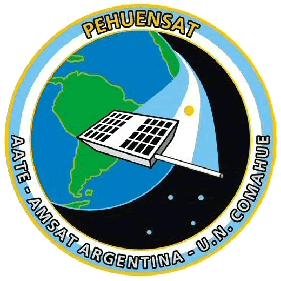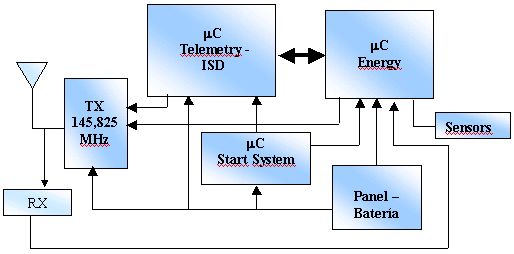PO-63  PEHUENSAT-1 PEHUENSAT-1
Educational Satellite for all school levels
Launch !!
Video
K E P S
Hear !
Why Pehuensat ??
TLM Info
Video
India Launch Jan-10
Where Now?
AATE Info
IARU Info
Location
Detail
Developed
in association between:
1.-
1.- Project Goals:
Develop. Build and operate a small satellite (Nano satellite) whose mission is educational, technological and scientific. This satellite will allow us to gain an important experience for future projects as part of the Pehuensat Program, with more complex missions, but accomplishing the three main goals of the project.
Educational:
Every attempt has been made to allow students of elementary, high school , colleges and universities participate in the project. University students of the School of Engineering of the Universidad Nacional del Comahue participated in design, manufacturing and integration of the nano-satellite. Elementary and high school students of Argentina will be able to participate using the satellite in their schools.
Scientific-Technological:
The design, construction, launch and operation of the satellite is by itself a scientific and technological challenge, that will help to gain knowledge and experience in space technology.
2.-
Responsibilities of organizations involved.
Universidad Nacional del Comahue (School of Engineering): Manage the project since creation of the team, design, constructions, tests, operation and financial resources.
Argentine Association for Space Technology (AATE):
participate in the planning team, to help to create the technical specifications and satellite mission. Brief the School of Engineering in the management of the project and design due the experience of AATE in this issue. Operate jointly the satellite one in orbit. Also AATE is the responsible party regarding launch service contracts, preparations, final integration and launch management.
AMSAT Argentina:
participate in the planning team, to help to create the technical specifications and satellite mission. Consult with the School of Engineering regarding the communications systems of the satellite due the AMSAT experience with the First Argentine Satellite (LU-SAT). Cooperate to achieve the educational goals of the project in elementary and high schools, providing equipment, when possible, and speakers to schools whom want to participate in the project, and allowing the use of the satellite between the students and the amateur radio community of Argentina.
3.- Characteristics:
3.1.-
Introduction:
The Pehuensat nano-satellite was designed not only taking into account the mission itself, but also other factors , as the conditions in Argentina, and regional and international constraints.
In Argentina, the space industry practically do not exist. We have some basic capability with some interesting developments in the past, but it is just starting. There are not yet providers of space-qualified hardware, or components.
Also every participating organization have to face a reality which is part of the country’s economical problems. Lack of funding, infrastructure, and human resources make these projects difficult.
In the international arena we have several factors that helps the project. The technological advances allows smaller components and systems, more economical and with globalization, there products are available. Also, nowadays there are several providers of space transportation systems competing in price and service.
The Pehuensat Project being a joint endeavour of the Universidad Nacional del Comahue, the Argentine Association for Space Technology, and AMSAT Argentina, all non for profit organizations, and with the education as the ultimate goal, will allows to address the national, and regional constraints, and will permit the formation of human resources for the betterment of the region.
3.2.-
Electronic Design:
As shown in the figure the new design includes the following:
Two 6V/300MA Solar Cells
RX: Contingency Receiver
Alcaline battery bank
Two groups of alcaline NiCd baterries
Antenna: V Dipole.
Transmitter:
The transmitter frequency is 145,825 MHz. It is an standard equipment that has been converted to the space environment. Several components has been replaced to endure the space environment (radiation protection, vaccum, microgravity).
Satellite Control and Communications are controlled by the RX receiver uplink channel
Voice Processing:
The data package to be transmitted includes temperatures in various areas of the satellite and power information.
These values are needed to direct the messages to the transmitter.
This figure shows how the system works:
The Integrated Storage Device (ISD) is the part in charge of store the messages in audio form. The storage capacity is 60 Seconds (about 480 KB at 8 Khz).
Messages
Telemetry will be broadcasted in two languages, one of them Spanish. The messages will be recorded on Earth in order to maximize memory.
The messages will be, satellite identification, natural numbers, sign, decimal point and the name of the measured variable.
AX25:
Telemeter AX25 on the same microcontroller (HC11 family) controlling the ISD to allow telemetry in packet with Ham radio protocol (1200 Bauds).
A typical message will require 35 seconds. The information broadcasted will be:
i) Announcement (ID) and basic telemetry in two languages (English, Spanish).
ii) Packet Telemetry.
The TX timing will be regulating depending the batteries charge status. The main processor decides time rates in regard to broadcasting on/off relation. (1:3; 1:5; 1:7; etc).
Master Control:
It is totally designed, built and tested (hardware and software). Also it was tested the “master/slave” communications interface. The circuit board was designed.
Energy Management:
This system works as slave of master control
- Hardware and software are totally designed and tested at prototype level. The control support board was designed.
- Temperature measurement system tested and calibrated in prototype phase.
- Battery status system (voltage) tested and calibrated in prototype phase.
- Solar panels charge monitoring (current) tested and calibrated in prototype phase.
- Two solar panels (300 mA).
- Battery Pack (no rechargeable)
- Two Battery packs (rechargeable)
Software is designed in two main parts:
:
Main Software:
The main function is the management of energy on-board. To do this the software measures the information received by the different sensors (temperature and voltage).
:
Periodic execution routine:
This routine, by interruption, performs the conversion of the analog information of the measurement sensors and transforms it to binary data. This information is sent by the synchronous interface of the micro-controller and from them to the transmitter as telemetry packet.
Housekeeping and ground testing software:
A dedicated software was designed to detect failure, to allow ground tests and to activate pre-flight commands.
Battery support: The Battery support is made of PTFE.
Antennas: The antennas are pre-designed, final design will depend of launch vehicle constraints.
Stand-by to Start System:
The start system is made with accelerometers of 2 axis to a semiconductor of low energy (AXDL250) which will start a timer based on a PIC micro-controller.
3.3.-
Structural Design:
It is a box type structure, where on of the faces is bolted to the last stage of the launch vehicle. The upper side of the structure holds the solar panels and the antenna. The material used is aluminum of aerospace grade, and it is also used stainless steel and PTFE. Total mass is 5 Kg.

4.-
Status of the project as December 2003:
INITIAL:
The project began in November 1997 with the approval of the board of the School of engineering of the University, and AATE and AMSAT Argentina. The signature of the agreements was made March 20, 1998.
The organizations involved decided to have a free information criteria, so all the design information of the Pehuensat is available to the community. A web page has been created to disseminate the information about the satellite.
DEVELOPMENT STATUS:
By December 2003 the satellite is completed in a 95%. The last tasks to perform are the positioning of the antennas (depending of the launcher) bolting to the vehicle and starting system.
Prototype of Pehuensat showing the solar panels.
Interior view of satellite and main components.
Launch of the Pehuensat :
At this moment several opportunities to launch the satellite are being pursued.
Profesor & Director of Investigation Project
Eng. Jorge Lassig.- Email: lassig@uncoma.edu.ar
AATE Neuquén & AMSAT LU Pehuensat Coordinador
Eng. Alejandro D. Alvarez LU8YD.- Email: lu8yd@amsat.org
| 










